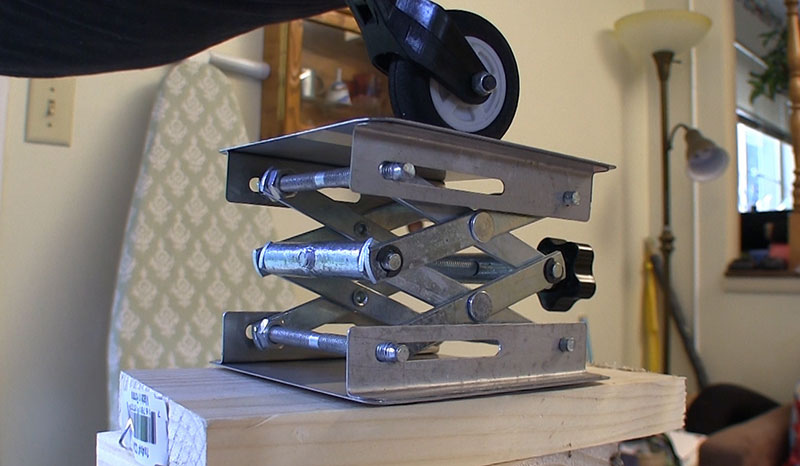



While visiting a good friends shop I noticed this scissor stand and had to have one. It makes leveling a plane
simple and lets me be dead on accurate without the adult language.
Text, photos and video by Tom Hintz
Posted - 5-10-2019
I have this flying friend, Dennis Shaver. Aside from being a super-smooth pilot, he is an even better builder. He also actually knows how to use tools like incidence meters and stuff which I suspect contributes to the smooth-flying thing. When I have an issue with a plane that I don’t understand (big shock there) Dennis is the guy I go to because he usually does
The last time I was in his shop I noticed a cool-looking scissor stand and found out he uses that for getting the tail wheel at the proper height to zero out the wing incidence at the root so he can check for problems, including twists across the length of the wing. I’d put money on him not finding twists in his wings with equal cash betting on him finding errors in my wings. He undoubtedly uses the scissor table for more things, but for now I am focused on checking wings on one of my planes. I have the most trouble coming up with what the Micro Trader Scissor Lift could be used for in a lab….
The Micro Trader Scissor Lift has 100 x 100mm (measures 3-7/8” by 4”) tables and is made primarily from stainless steel. The arms that make up the scissor system appear thick for the job but make it stable and obviously durable. There is no plastic anywhere but in the finger knob itself. The bottom surface has four rubber feet/pads that are skid resistant.
The finger knob drives a threaded shaft that actuates the scissor mechanics. The threading on that shaft gives us very good control when trying to get a plane perfectly level. It has a height range of 1-3/4“, when fully down to 6-1/8“, when “scissored” all the way up. I realize this range will not handle all of our needs, but we can set the Micro Trader Scissor Lift on a stack of wood or other “laying around debris” our shops usually have too much of and use the Micro Trader Scissor Lift to fine tune the angle of the plane. Not brain-intensive to use.
The threaded rod assembly does not lock but has sufficient drag that it doesn’t need one. Turning the finger knob is easy but it stays where you left it. I have not found anything that happens in the real world of setting up a plane that makes the Micro Trader Scissor Lift change heights without us turning the finger knob.
The Micro Trader Scissor Lift that appears mechanically simple but would be a veritable bear to make ourselves. Factor in the surprisingly low $19.29 (5-10-2019) price tag and there exists no sound reason to not have one if you fly and hopefully set up your model airplanes. Being made of stainless steel the Micro Trader Scissor Lift refuses to be one of those tools that slowly turns to rust between uses. It functions well and will continue to do so if we can avoid doing something catastrophic to it.
Though at the moment the Micro Trader Scissor Lift in my shop has been used to level a fuselage to check for incidence errors, there is little doubt its use in other ways will benefit our work in the shop that can directly affect how a plane flies, including how it doesn’t crash. As happens with many of the tools I buy, once it is in my shop, I undoubtedly will find other uses. The Micro Trader Scissor Lift borders on being a must-have tool though we do not yet know why.
Have a comment on this Review? –Email Me!